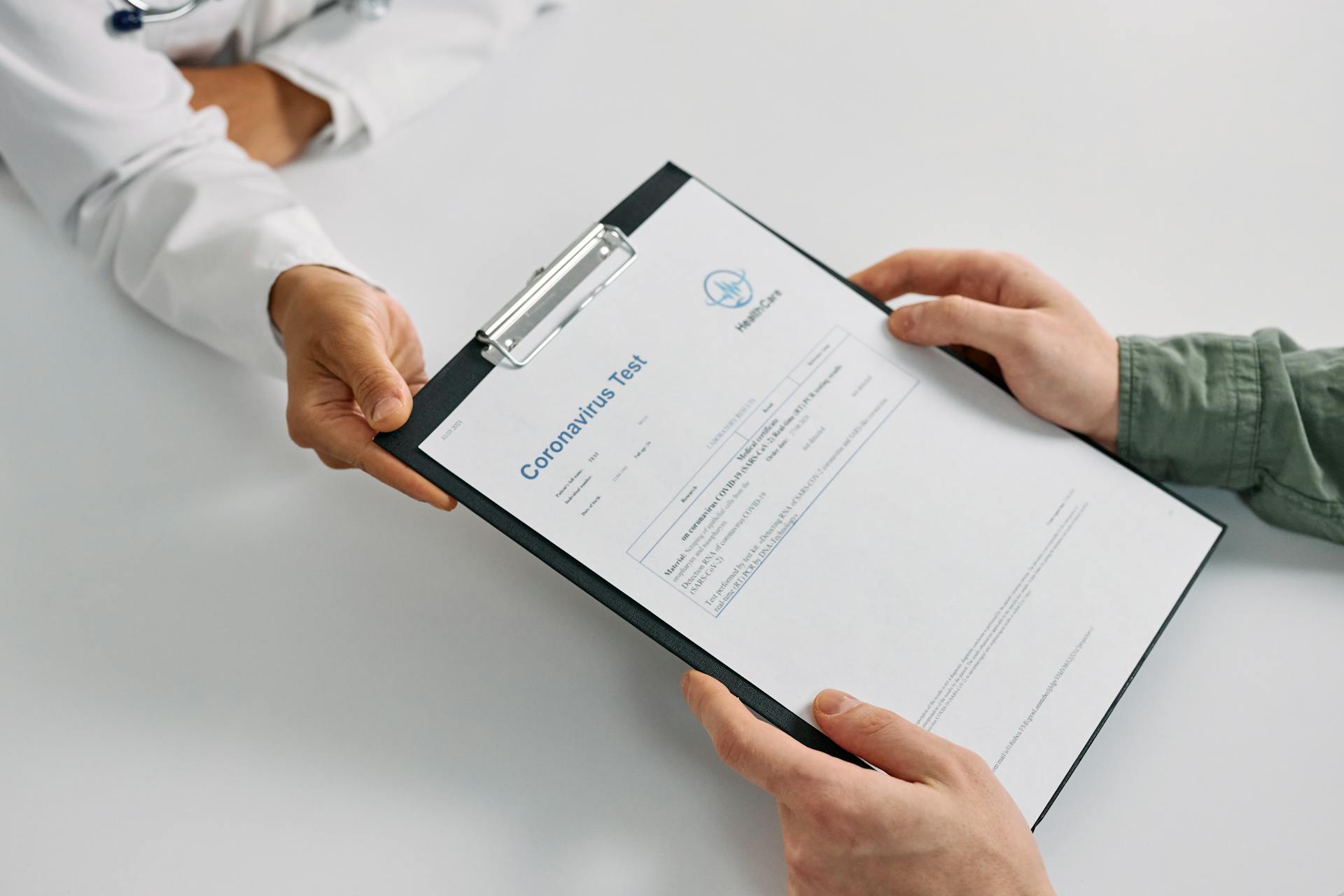
Payment posting is a crucial step in the medical billing process, and understanding it can help ensure accurate and timely reimbursement. It involves verifying the payment details and applying the funds to the patient's account.
The payment posting process typically begins with a review of the patient's account to ensure all payments are up-to-date. This includes checking for any outstanding balances or unpaid claims.
A key aspect of payment posting is identifying and correcting any errors or discrepancies in the payment process. This can include issues with insurance claims, patient payments, or billing errors.
By streamlining the payment posting process, medical practices can reduce the risk of delayed or denied payments, and improve overall revenue cycle management.
Explore further: India Post Payments Bank
Medical Billing Basics
Payment posting in medical billing is a crucial step in revenue cycle management. It provides a quick snapshot of a practice's financial strength.
Payment posting involves logging payments into the system, giving a clear overview of payment details and collections through various payers. This includes insurance payments through EOBs (Explanation of Benefits) and ERAs (Electronic Remittance Advice), as well as payments from patients.
Recommended read: Does Blue Cross Blue Shield Accept Credit Card Payments
Efficient payment posting helps practices understand their day-to-day financial status. It also facilitates better cash flow by ensuring timely receipt of payments.
Accurate payment posting involves tracking and accounting for services provided to patients, submitting claims to insurance providers, reviewing claim information, and coordinating claim payment posting with patient payments. This process should be done on a timely basis to ensure maximum reimbursement in the minimum amount of time.
Payment posting can be a time-consuming and complicated process, especially when done manually. Human error can lead to lost revenue and additional labor costs.
Medical billing solutions like PrognoCIS can help streamline the payment posting process by including features such as batch EOB posting, electronic claims submissions, and automated patient statements. These tools can also help automate the processing of adjustments and write-offs, identify issues that need correction, and apply patient copays.
Here are some key features of payment posting in medical billing:
- Automatic matching of EOB data against payments
- Accurate and timely EOB and ERA posting and reconciliation
- Automated processing of adjustments and write-offs
- Issue identification and routing to the right person
- Patient copay application and remaining balance processing
- Native support for patient payment plans, collection agencies, and more
Revenue Cycle Management
Revenue Cycle Management is a crucial aspect of medical billing that involves efficiently processing payments to ensure timely and accurate financial transactions.
A smooth payment process flow is essential to observe everyday trends and identify opportunities to increase revenue.
Analyzing payment postings can help healthcare providers evaluate the revenue cycle and pinpoint areas where improvements could be made, ultimately maximizing profits and efficiencies.
Proactive denial follow-up and management can be achieved by status full and partial denials at the payment posting stage, expediting denial resolution time and minimizing delays in payment processing.
Readers also liked: Medical Payment Processing
Denial Follow-up and Management
Denial follow-up and management is a crucial step in the revenue cycle management process. Proactively status full and partial denials at payment posting stage can help prevent further delays.
This proactive approach can help identify and resolve issues quickly, reducing the likelihood of prolonged payment delays. Analyzing payment postings can also help resolve denials in a more timely manner.
See what others are reading: Prior Authorization Management
By reviewing the reasons for denial, healthcare providers can take corrective measures to ensure all payments are posted correctly and promptly. This can help patients avoid due payments and reduce the financial burden on them.
Identifying errors or inaccuracies in payment postings can also help healthcare providers improve their billing processes and prevent similar issues in the future. This can lead to increased efficiency and reduced costs in the long run.
Discover more: Water Bill Online Payments
AI in Modern Revenue Cycle Management
An efficient payment process workflow and system helps observe everyday trends in the payment process and identify opportunities to increase revenue.
By analyzing payment posting, healthcare providers can evaluate the revenue cycle and pinpoint areas for improvement, which can maximize profits and efficiencies of accounts receivable departments.
A smooth payment posting process flow increases the potential output of the entire medical billing process, allowing for timely and accurate payment processing.
Effectively analyzing payment posting can minimize delays in payment processing and improve the billing cycle, which is crucial for healthcare providers to maintain a smooth revenue cycle management process.
The right payment posting process flow is integral to the entire revenue cycle management process, enabling healthcare providers to make data-driven decisions and optimize their revenue cycle.
For your interest: Health Care Financial Management
Payment Posting Process
The payment posting process is a crucial step in medical billing, and it's essential to get it right to avoid any issues down the line.
Accurate payment posting is vital to the healthcare service's financial status, and it's what sets a thriving business apart from one that's struggling.
The process flow in payment posting should be integral to the entire revenue cycle management process, as it helps identify opportunities to increase revenue and observe everyday trends in the payment process.
Manual payment posting involves entering payments into the patient's account one by one, which requires medical billing staff to review and process each invoice and payment accurately.
To apply a payment to charges, you need to match the remit payment to the correct charge by verifying the Begin and End dates, Procedure code, and Amount Billed.
You then need to click on the line of the charge inside the Allowed Column and enter the amount shown on the EOB as the Allowed amount.
A fresh viewpoint: Health Insurance for Small Business with One Employee Cost
If applying a secondary or tertiary payment and not taking an adjustment, leave the Allowed amount blank and click inside the Provider Paid column.
You'll also need to tab to the next column and enter any amount that was applied to the deductible, CoInsurance, etc.
After that, tab to the Adjust Codes column and the total adjustment amount is displayed on the first line of the Adjustment Codes dialog.
Adjustments can be broken down by manually changing the amounts, selecting the Adj Group and Code, and tabbing to the next line, as needed.
Once you've completed the payment posting process, you'll need to verify the Next Action, which determines whether a secondary claim is generated or if the balance is patient responsibility.
Finally, click Save Claim, and a pop-up message will verify payment was saved; click OK.
When the Remaining Balance in the upper section/Remit details is zero, the Remit/EOB will need to be posted to the patient ledger and closed.
Explore further: How Much of Your Medical Bills Are Tax Deductible
Things to Watch Out for
Data from posting should match EOBs and ERAs received to avoid surprises later on. Regular reconciliation helps to ensure accuracy.
Denial management is crucial to prevent delays in revenue inflow and potential write-offs. Delays can lead to increased write-offs, so it's essential to work closely with the denial management team.
Patient payment responsibilities should be identified and conveyed early on to facilitate a faster collection cycle. This includes co-pays, non-covered services, and other patient obligations.
Balancing write-offs requires a detailed process that indicates client-specific levels for write-offs and adjustments. Any deviation requests should be notified immediately to prevent loss of revenue.
Contracts and fee schedules should be reviewed regularly to ensure accurate posting of payments and adjustments. This helps prevent misrepresentation of financial status and ensures timely revenue inflow.
Here are some key areas to review in payment posting:
- Data from posting matches EOBs and ERAs received
- Patient payment responsibilities are identified and conveyed
- Write-offs are balanced with client-specific levels
- Contracts and fee schedules are reviewed regularly
Point of Service Reconciliation
Point of Service Reconciliation is a critical step in medical billing, and it's where accuracy really matters. Our team completes faster and more accurate posting and reconciliation of cash, check, credit card payments.
To ensure accuracy, we batch process payer ERA's, which helps streamline the process. This allows us to reconcile payment postings with accounting records.
Faster and more accurate posting means you get paid faster, which is a big plus for your business. Our team works efficiently to get the job done.
Reconciliation is not just about posting payments, it's also about tracking trends, outstanding balances, and revenue received for financial analysis and reporting purposes. This helps you make informed decisions about your business.
A fresh viewpoint: Health Insurance for Business Owners
Automated Payment Posting
Automated payment posting is a game-changer for medical billing staff. It uses technology to quickly and accurately enter payments into a patient's account, eliminating manual data entry and reducing errors.
This process is more efficient and cost-effective than manual payment posting, allowing providers to process payments quickly and receive them faster. This is especially important for cash flow.
Automated payment posting reduces the time and effort required to post payments, freeing up staff to focus on other tasks.
For more insights, see: Automated Prior Authorization
Analyzing Payment Posting
Analyzing payment posting is essential for ensuring accurate and efficient payments. Errors can occur in two forms: incorrect payments or accounts being credited incorrectly.
Incorrect payments occur when a provider receives an amount that is different from what was billed. This can lead to financial instability and errors in the billing and payment process.
Analyzing payment posting accuracy is critical for preventing errors and discrepancies in the billing and payment process. Accurate payment posting ensures that all payments are correctly applied to the appropriate accounts.
A smooth payment process flow increases the potential output of the entire medical billing process. This is achieved by observing everyday trends in the payment process and identifying opportunities to increase revenue.
Accurate payment postings are those recorded correctly, ensuring that the proper amounts are credited to the appropriate accounts. This helps to maintain the financial stability of healthcare providers.
Success in submitting claims to secondary and tertiary payers relies heavily on the accuracy with which the primary payment was posted. Inaccuracies can lead to billing errors for subsequent payers.
Expand your knowledge: How Long Does Payment Process Take for Medical Incident
An accurate payment posting process, including reconciliation, is critical to the continued existence of a practice. Without a strong cash flow, a practice can't scale, retain employees, or maintain a competitive advantage.
Monitoring payment posting trends can help healthcare professionals ensure that their payments are processed quickly and accurately. This involves tracking changes in payment amounts, payment types, and other trends.
Improving Payment Posting
Improving payment posting is crucial for healthcare providers to guarantee accuracy and maximize their earning potential. By analyzing errors, existing documentation and processes, payment speed and accuracy, and trends in healthcare, providers can quickly identify issues affecting their cash flow.
Accurate payment posting also helps to improve patient relationships by providing faster and more accurate payments. This can make a huge difference in customer service, as patients will be more satisfied when they receive their payments quickly and without any discrepancies.
To improve payment posting, healthcare providers should match EOB data against payments received. This helps to identify any discrepancies or issues with payment processing.
Accurate and timely EOB and ERA posting and reconciliation is also essential for improving payment posting. This ensures that payments are processed correctly and efficiently.
Here are some key benefits of improving payment posting in medical billing:
- Matching EOB data against payments received
- Accurate and timely EOB and ERA posting and reconciliation
- Processing adjustments and write-offs against contractual agreements
- Identifying non-covered service, denial, prior authorization, and collection issues to be rectified
- Claim denial management to quickly identify denials, rework claims, and resubmit
- Applying patient Copay and move remaining outstanding balances to the patient’s account for processing
- Supporting Patient Payment Plans and Collection Agency workflows
- Improving revenue cycle management
By implementing these strategies, healthcare providers can improve payment posting, reduce errors, and increase patient satisfaction.
Frequently Asked Questions
What is the difference between payment posting and cash posting?
Payment posting refers to payments from insurance companies, while cash posting refers to payments made by patients or self-pay individuals. Understanding the difference is crucial for accurate financial tracking and management.
What is era in payment posting?
An ERA (Electronic Remittance Advice) is a transaction that provides payment information to healthcare providers, including claim adjustments based on contract agreements. It helps providers understand payment details and make informed decisions about their claims.
Sources
- https://businessintegrityservices.com/payment-posting-in-medical-billing/
- https://triumphealth.com/solutions/revenue-cycle-management/payment-posting/
- https://www.enter.health/post/healthcare-industry-reforms-payment-posting-in-medical-billing
- https://soapware.screenstepslive.com/s/SLC/m/new_PM_manual_current/l/52901-introduction-to-insurance-payment-posting
- https://prognocis.com/eobs-and-payment-posting/
Featured Images: pexels.com


